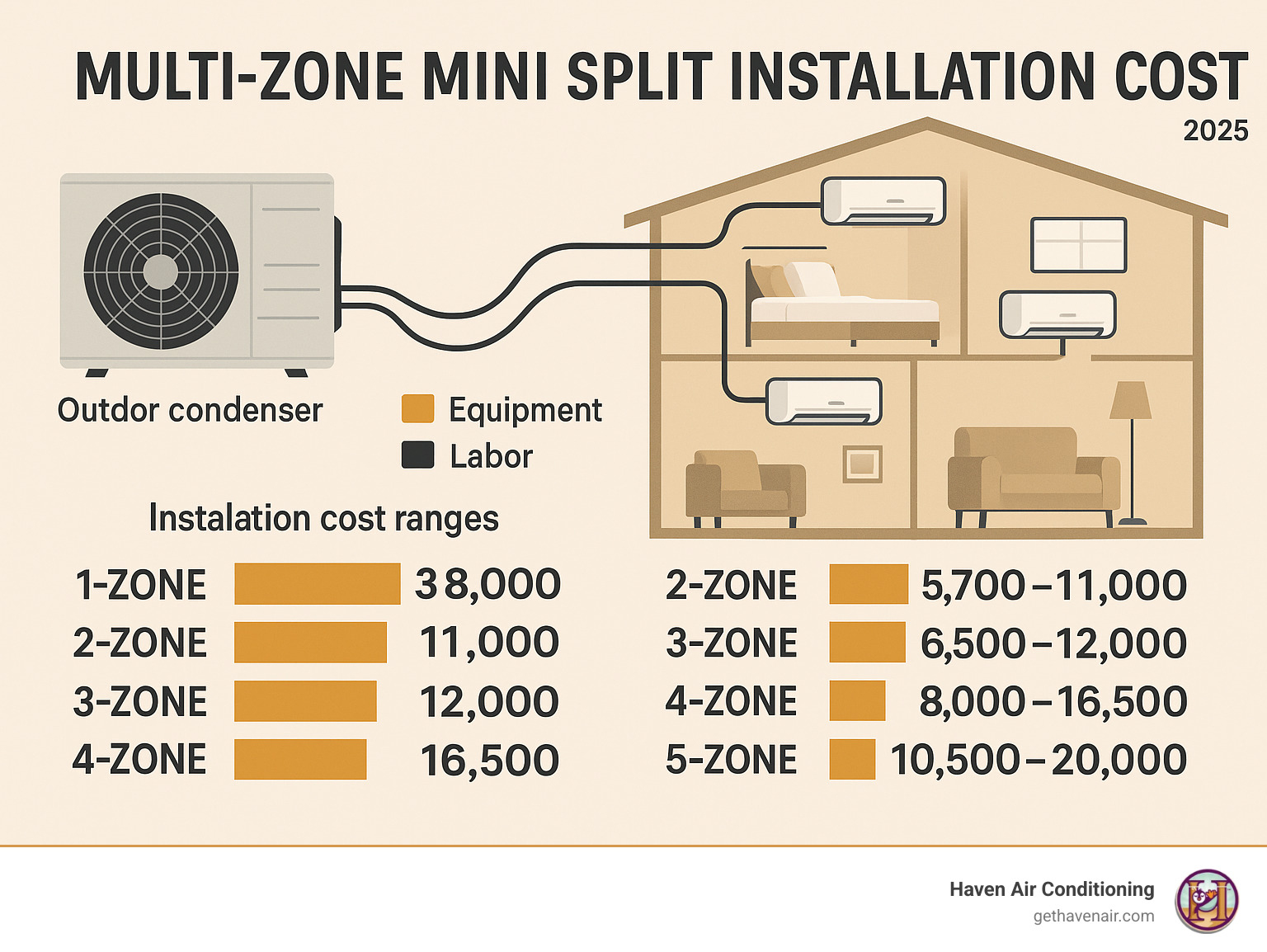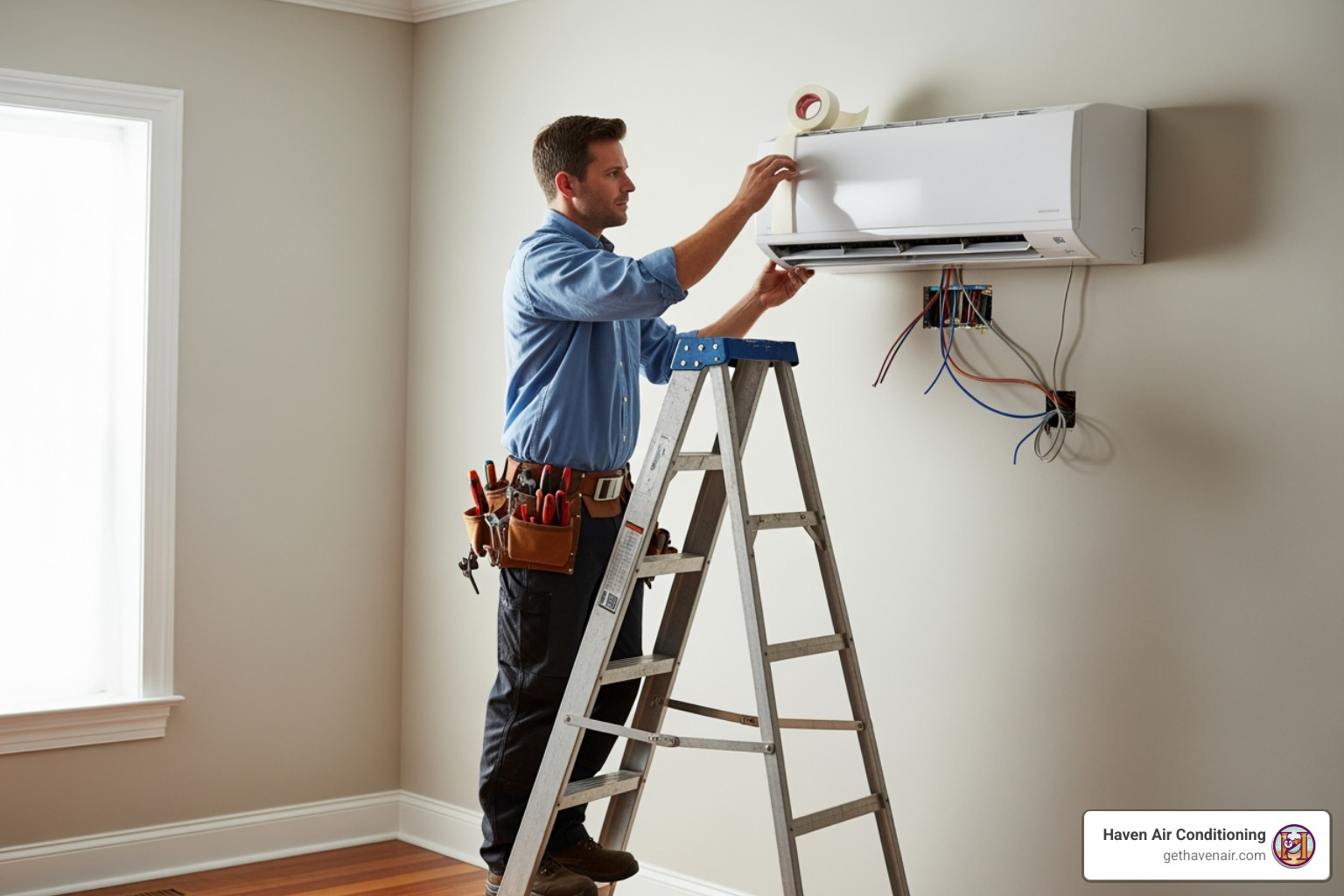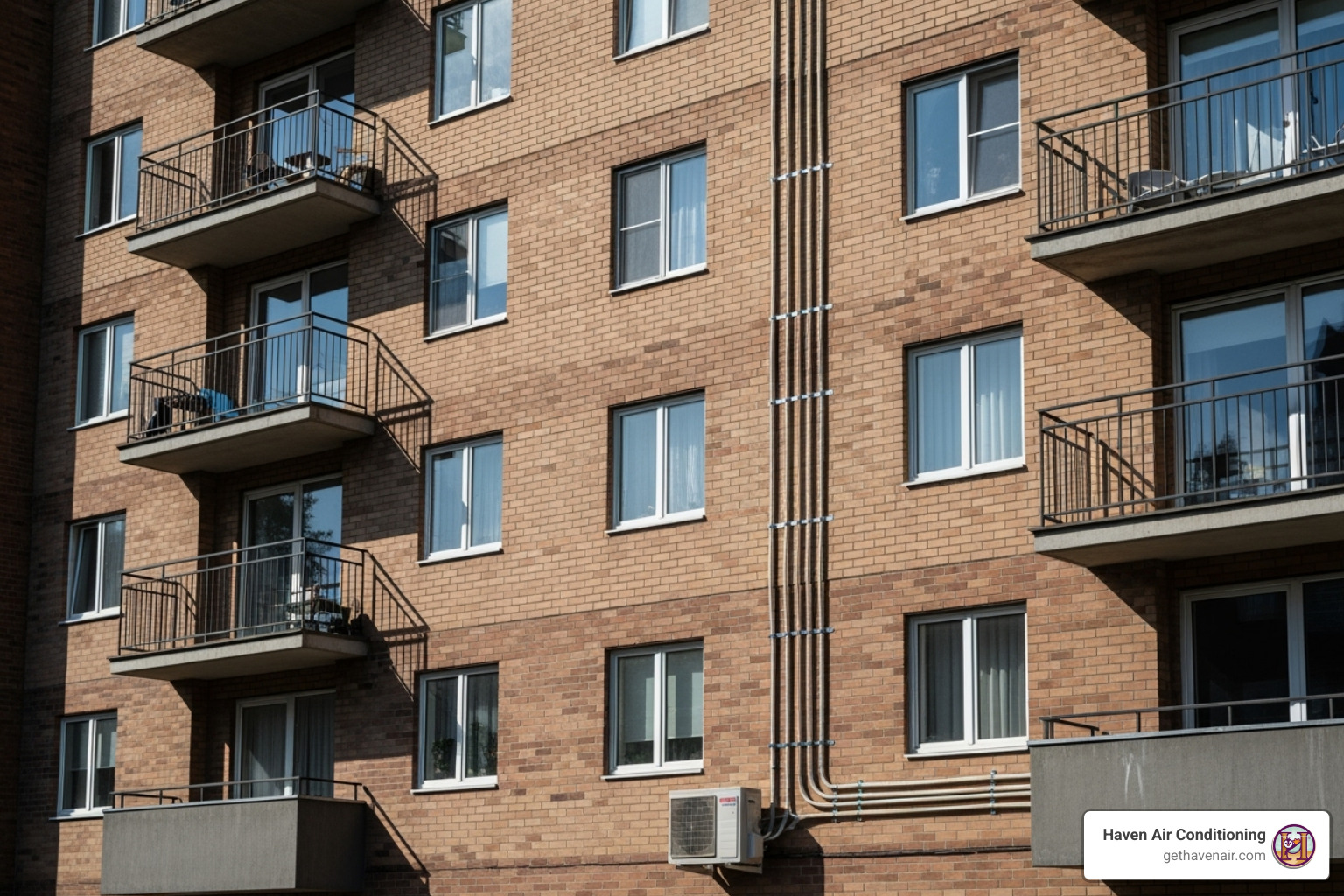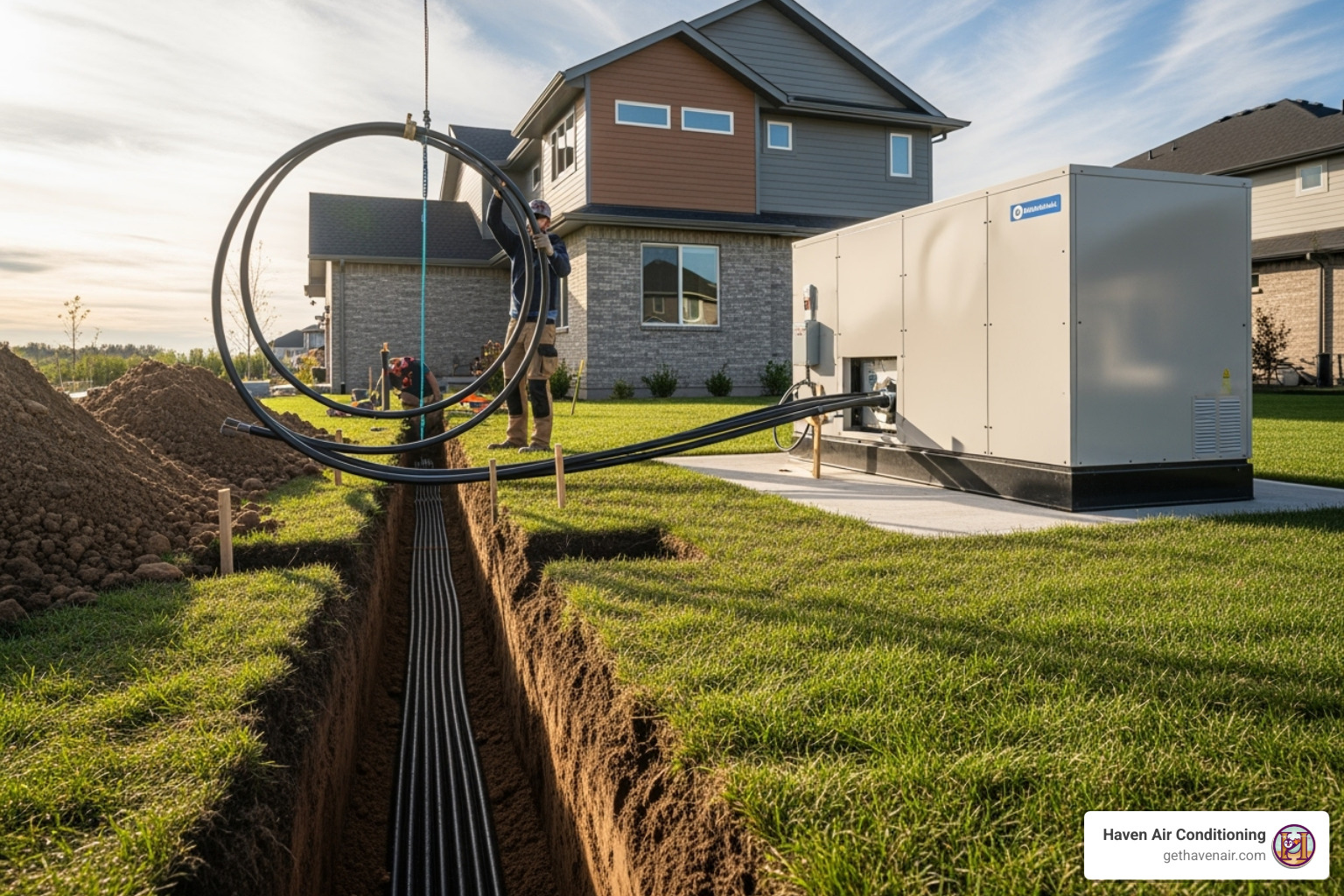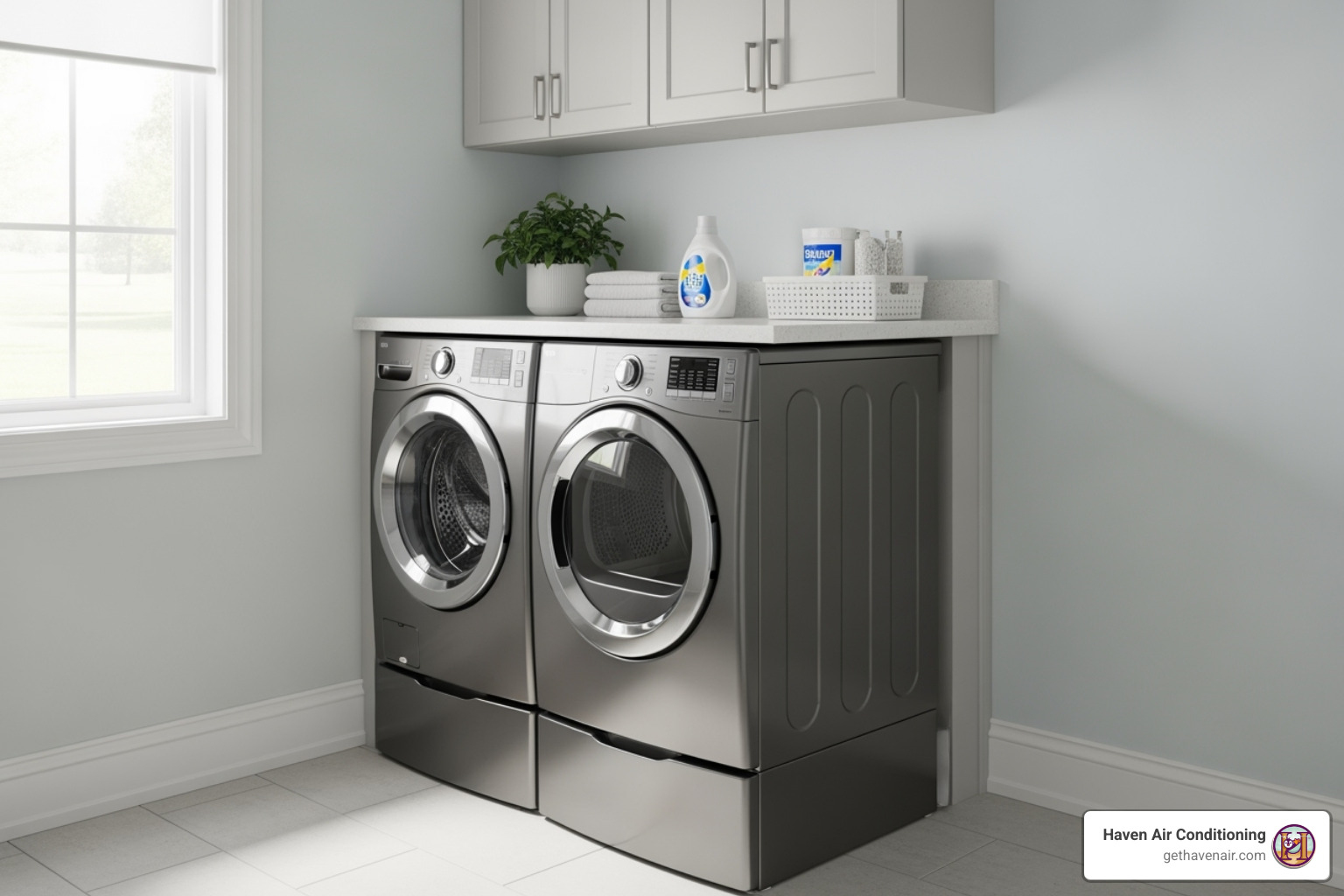Understanding Multi-Zone Mini Split Installation Costs: What You Need to Know
Multi zone mini split installation cost varies based on the number of zones and your home’s setup. Here’s a quick overview of what Orange County homeowners can expect:
Quick Cost Overview:
- Single-zone systems: $3,500 – $8,000 installed
- 3-zone systems: $6,500 – $12,000 installed
- 5-zone systems: $10,500 – $20,000+ installed
- Labor costs: $700 – $3,000+ for multi-zone installations
- Cost per additional zone: Approximately $1,500 – $3,000
If you’re struggling with uneven temperatures, high energy bills, or an old HVAC system, a multi-zone mini split is an excellent solution. These systems let you heat and cool different areas of your home independently, ending thermostat battles and saving energy on unused rooms.
With one outdoor unit powering multiple indoor units, you get precise comfort control and potential energy savings over traditional central air. However, installation costs vary based on your home’s layout, choice of indoor units, and overall complexity. Understanding these factors helps you budget effectively and avoid surprises.
What is a Multi-Zone Mini Split and How Does It Work?
A multi-zone mini split system offers a modern approach to home comfort, which is why so many Orange County homeowners are making the switch. Unlike traditional HVAC, multi-zone mini splits use ductless technology for precise control over individual rooms or “zones.” The system consists of one outdoor condenser unit connected to multiple indoor air handlers via slim refrigerant lines. This eliminates the need for bulky ductwork, providing efficient climate control exactly where you need it.
With individual zone control, each indoor unit operates independently, allowing for different temperature settings in different rooms. These systems provide both heating and cooling, making them ideal year-round solutions for the Southern California climate.
Your choice of indoor units impacts the final multi zone mini split installation cost.
- Wall-mounted units: The most popular and budget-friendly option, ideal for most rooms.
- Ceiling cassette units: Install flush with the ceiling for a discreet look, great for open floor plans.
- Floor-mounted units: Sit low on the wall, perfect for rooms with sloped ceilings or limited wall space.
- Concealed duct units: The most integrated and expensive option, hidden from view and connected to short duct runs.
Key Components and Their Function
Key components work together for maximum efficiency. The outdoor compressor and condenser coil manage the refrigerant, while the indoor evaporator coil delivers conditioned air. Thin refrigerant lines connect the units, a far less invasive option than traditional ductwork. Each zone is managed by a remote control, and many systems are compatible with smart thermostats for control via your smartphone.
The Advantage of Zoned Climate Control
The advantages of zoned climate control include:
- Energy Efficiency: Save money by only conditioning the rooms you’re using.
- Personalized Comfort: End thermostat battles by setting different temperatures in each zone.
- No Ductwork Required: A major benefit for older homes or new additions in Orange County, avoiding costly and disruptive duct installation.
- Quiet Operation: Indoor units are whisper-quiet, with the noisy compressor located outside.
- Improved Air Quality: Built-in filters help capture dust, allergens, and other airborne particles.
Breaking Down the Multi Zone Mini Split Installation Cost
When considering the multi zone mini split installation cost, it’s important to know that there’s no one-size-fits-all price. The final cost depends on several key factors. Much like buying a car, features and complexity determine the price. Understanding these drivers helps you make smart choices for your budget.
The total investment includes equipment costs (the units themselves) and labor costs (professional installation), both of which are crucial for a reliable system.
Average Multi Zone Mini Split Installation Cost by Number of Zones
The biggest factor in your multi zone mini split installation cost is how many rooms you want to control. Each additional zone requires another indoor unit, more materials, and extra installation time.
| System Type | Typical Installed Cost Range |
|---|---|
| Single-Zone | $3,500 – $8,000 |
| 2-Zone | $4,500 – $8,000 |
| 3-Zone | $6,500 – $12,000 |
| 4-Zone | $8,500 – $16,000 |
| 5-Zone | $10,500 – $20,000+ |
These ranges are a general guide. A straightforward installation in a single-story home will be on the lower end, while a complex setup in a multi-story house will cost more.
Cost by Indoor Unit Type
The type of indoor unit you choose significantly impacts the cost and aesthetics of your system.
- Wall-mounted units: The most affordable and common option, easy to install and great for most rooms.
- Ceiling cassette units: Offer a sleek, built-in look by sitting flush with the ceiling. They cost more and require more complex installation but are ideal for open floor plans.
- Floor-mounted units: A mid-range option that works well in rooms with sloped ceilings or limited high-wall space.
- Concealed duct units: The premium choice for a virtually invisible look. They are the most expensive due to the need for short duct runs and complex installation.
How Equipment Quality and Warranty Affect Price
Not all mini splits are created equal. Price varies based on equipment quality and features. Higher-end systems generally offer better energy efficiency, quieter operation, and smart home integration. They also come with stronger warranties, which can save you money on future repairs.
A robust warranty often signals a more reliable product. While premium brands cost more upfront, they can provide better reliability and lower long-term operating costs. We help Orange County families find the right balance between budget and features to ensure long-term value.
Key Factors That Drive Your Final Price
Beyond the number of zones, several other factors influence your final multi zone mini split installation cost. The unique layout and construction of your home play a significant role. Understanding these variables helps you create a realistic budget and avoid surprises.
Equipment Specifications: BTU and Efficiency
Proper sizing is crucial for efficiency and comfort. An HVAC contractor will perform a calculation based on more than just square footage, considering factors like ceiling height, windows, and insulation. The system’s power is measured in BTU (British Thermal Units); an incorrectly sized system will be inefficient and ineffective.
Efficiency ratings also impact cost. SEER2 (cooling) and HSPF2 (heating) ratings indicate how efficient a unit is. Higher-rated, energy efficient systems cost more upfront but lead to significant long-term savings on energy bills.
Installation Complexity and Labor Costs
Installation complexity is a major driver of labor costs, which typically range from $700 to over $3,000 for multi-zone systems. Key factors include:
- Location of units: Multi-story homes or cramped attics require more labor than simple first-floor installations.
- Accessibility: Tight spaces for outdoor or indoor units can increase installation time.
- Refrigerant line length: Longer distances between units increase material and labor costs.
- Wall material: Drilling through brick or concrete takes more time and specialized tools than drilling through drywall.
Choosing a certified installer, such as one with NATE (North American Technician Excellence) certification, is crucial to ensure the job is done right, guaranteeing efficiency and reliability.
Additional “Hidden” Costs to Budget For
Be prepared for potential additional costs to avoid budget surprises. These can include:
- Electrical work: Most multi-zone systems require a new dedicated circuit, and older panels may need an upgrade.
- Permit fees: Required in most Orange County cities to ensure code compliance.
- Removal of old HVAC equipment: Disposing of old window units or central air systems adds to the cost.
- Condensate pumps: Needed if an indoor unit cannot drain via gravity.
- Wall brackets or condenser pads: Required to provide a stable, level surface for the outdoor unit.
- Line covers: An optional aesthetic upgrade to hide exterior refrigerant lines.
Mini Splits vs. Traditional Central Air: A Cost and Benefit Comparison
Homeowners often wonder whether to choose a multi-zone mini split or traditional central air. Both provide whole-home comfort, but they work differently. Central air is a good option if you have existing, efficient ductwork. Mini splits excel in homes that need zoning flexibility, have no ductwork, or where long-term energy savings are a priority.
Upfront Installation Cost
For homes with existing, efficient ductwork, replacing a central air unit can be less expensive upfront than installing a new multi-zone mini split. However, if your home lacks ducts, the tables turn. Installing new ductwork is a major, costly project, often adding $4,000 to $10,000+ to the price of a central air system.
In these cases, the multi zone mini split installation cost is often significantly lower because it avoids this expense and disruption. Even with existing ducts, the long-term energy savings of a mini split can quickly offset any initial price difference.
Long-Term Operating Costs and Energy Savings
Mini splits truly shine in long-term operating costs. Traditional central air systems can lose up to 30% of conditioned air through leaky ducts, wasting significant energy and money. Ductless mini-splits eliminate this problem by delivering air directly into the room.
The biggest advantage is zoned control savings. You can cool or heat only the rooms you are using, which dramatically reduces energy consumption compared to conditioning an entire house. This targeted approach leads to substantial savings on monthly utility bills.
Furthermore, modern mini splits use inverter technology, which adjusts the compressor speed to match demand, running more consistently and efficiently than traditional on/off systems. These higher efficiency ratings lead to lower utility bills and significant savings over the system’s lifespan.
How to Save Money and Maximize Your Investment
A multi-zone mini split is a significant investment. Fortunately, there are smart ways to reduce upfront costs and maximize your return through long-term efficiency and reliability. Every incentive claimed and efficiency gained means lower bills and fewer headaches.
Finding Rebates and Tax Credits
A great way to lower your multi zone mini split installation cost is through financial incentives designed to promote energy efficiency. Look for:
- Federal tax credits: Available for qualifying high-efficiency heat pump mini splits.
- State and local incentives: California and many Orange County cities offer rebates for HVAC upgrades.
- Utility company rebates: Your local utility provider likely offers cash back for installing efficient equipment.
- Manufacturer rebates: Often available on specific high-efficiency models.
Check the Database of State Incentives for Renewables & Efficiency (DSIRE) to find programs in your area. Combined, these incentives can reduce your total cost by thousands.
DIY vs. Professional: How It Affects Your Multi Zone Mini Split Installation Cost
While DIY mini split kits seem like a way to save money, the risks far outweigh the benefits. A DIY installation often leads to costly problems.
The primary risks include:
- Voided Warranty: Most manufacturers require installation by a certified professional to honor the warranty.
- Improper Sizing: Without a professional load calculation, your system may be inefficient and ineffective.
- Refrigerant Handling: Refrigerant requires licensed handling due to safety and environmental regulations.
The benefits of professional installation are clear: it protects your warranty, ensures safety, and guarantees your system operates at peak efficiency for maximum longevity. The initial savings of a DIY attempt are not worth the risk of voided warranties, poor performance, and premature system failure. Professional installation is an investment in your system’s long-term health and performance.
Frequently Asked Questions about Multi-Zone Mini Split Costs
Is a multi-zone mini split system worth the higher initial cost?
Yes. While the initial multi zone mini split installation cost can be higher, the investment pays off. The long-term energy savings from zoning, combined with customized comfort for every room, make it a worthwhile upgrade. It’s an especially valuable solution for homes without existing ductwork, where it is often more cost-effective and less disruptive than installing a traditional central air system.
How much does labor cost for a multi-zone mini split installation?
Labor for multi-zone installations typically ranges from $700 to over $3,000. The final price depends on several factors, including the number of indoor units and the complexity of the installation. Difficulties like multi-story layouts, challenging wall materials (brick, stucco), and long refrigerant line runs will increase labor costs. Regional labor rates in Orange County also influence the price. This cost covers the expertise of certified professionals who ensure your system is installed safely and correctly for optimal performance.
How much value does a mini split add to a home?
A mini split system can significantly increase your home’s value. It’s a highly desirable feature for buyers, especially in older homes without central air. It also adds value by making new additions and converted spaces like garages or attics comfortable and functional year-round. The system’s energy efficiency and modern zoned climate control are major selling points in the competitive Orange County real estate market, signaling lower utility bills and improved comfort to potential buyers.
Get a Precise Quote for Your Orange County Home
Understanding the variables of a multi zone mini split installation cost can feel overwhelming. While this guide provides a good overview, the only way to get an accurate price for your project is through a professional on-site assessment. Every home is unique and requires a custom solution.
The importance of a professional assessment is paramount. Our certified technicians evaluate your home’s layout, your family’s needs, and all the technical details to provide a precise quote.
At Haven Air Conditioning, we specialize in helping Orange County homeowners find the perfect climate control solution. Our expert consultation process is transparent and custom to you. We listen to your needs, explain your options clearly, and provide detailed quotes with no hidden fees or sales pressure.
Don’t let cost complexity prevent you from enjoying the comfort and savings of a mini split system. Let our experienced team provide a straightforward, stress-free assessment and quote.
Get a professional quote for your mini split AC installation.


